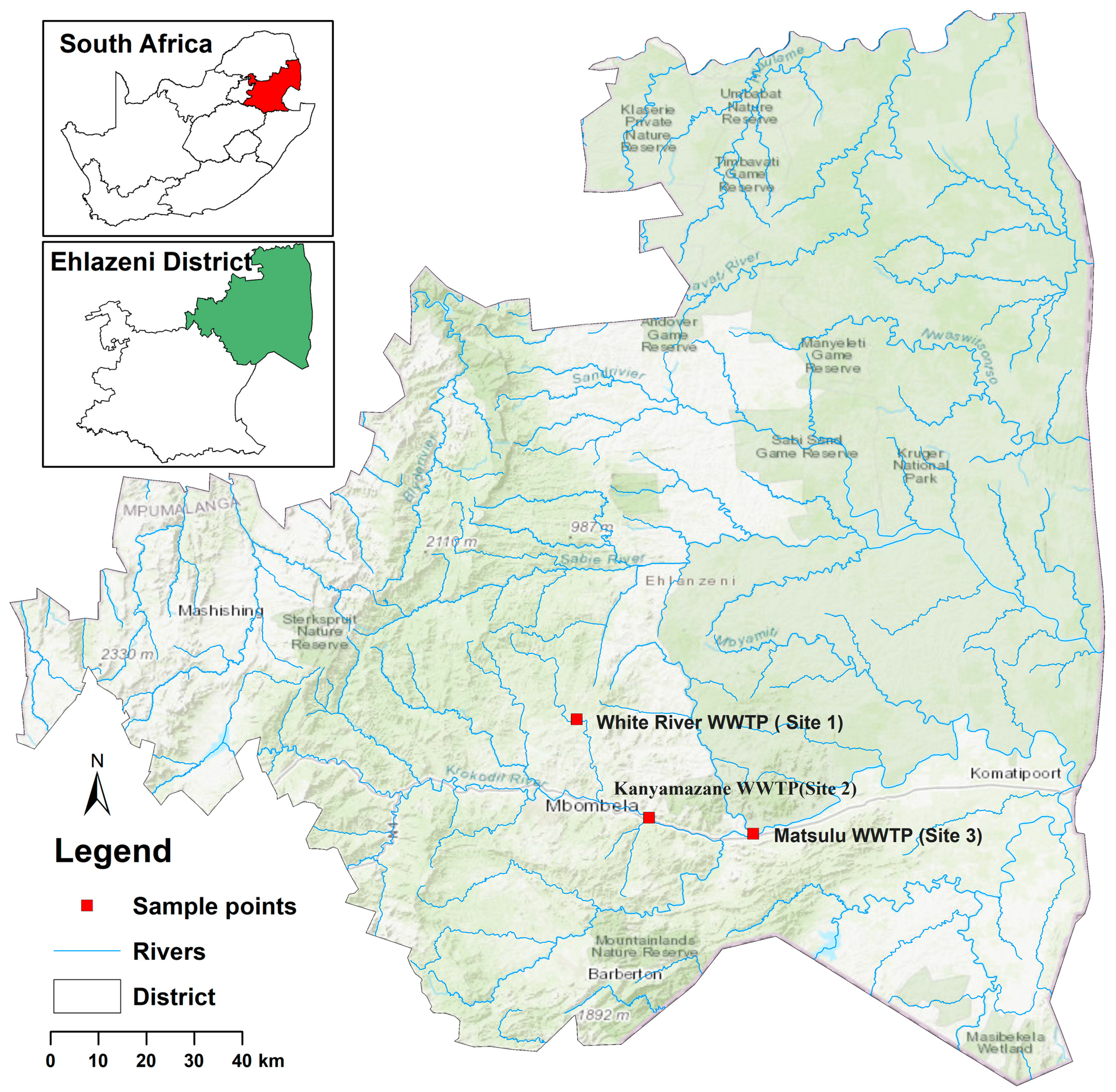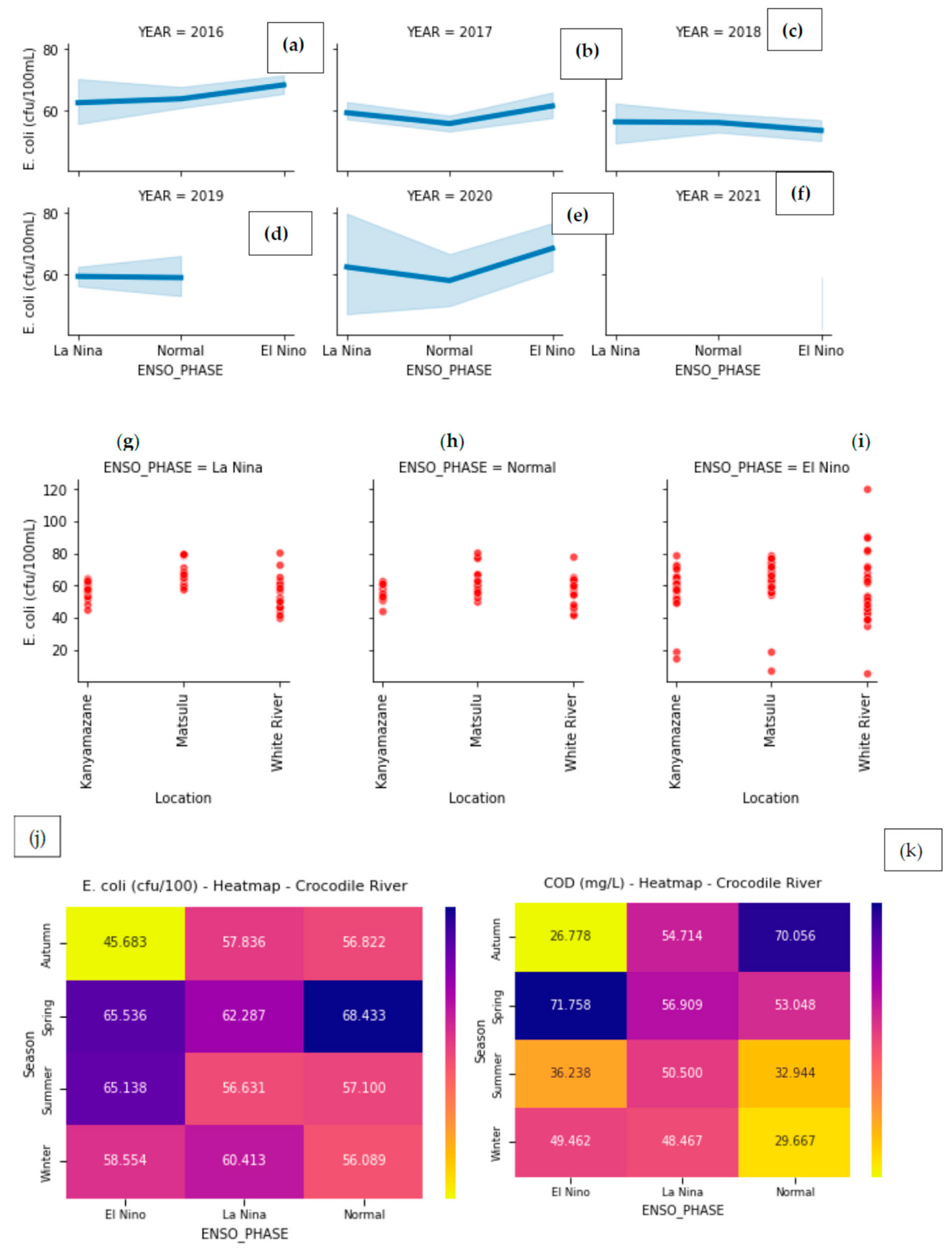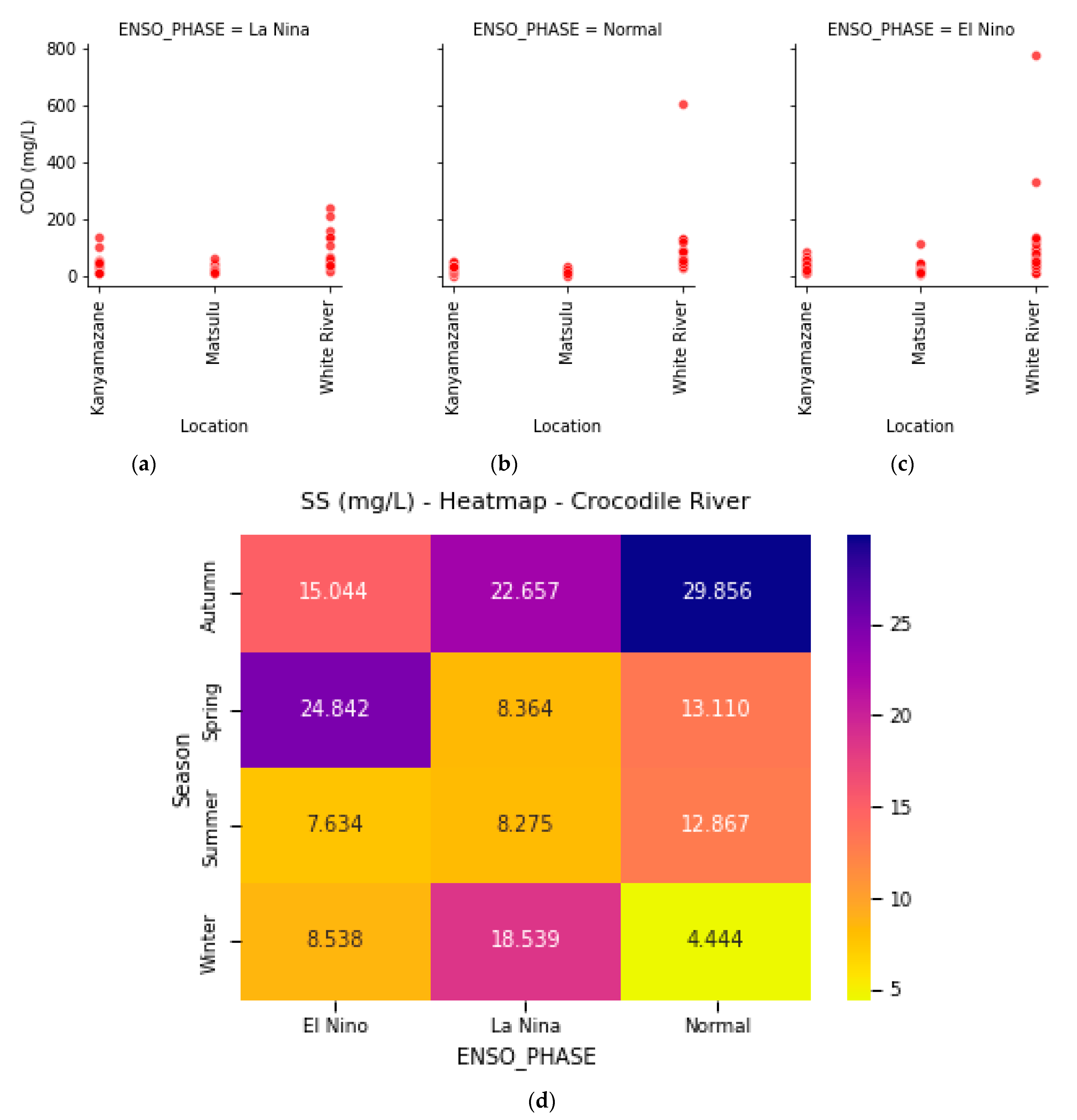El Niño Southern Oscillation (ENSO) Implication towards Crocodile River Water Quality in South Africa
Abstract
:1. Introduction
2. Materials and Methods
2.1. Study Area
2.2. Characterization of the Sampling Sites
- White River Wastewater Treatment Plant (WWTP) (Site 1)
- Kanyamazane WWTP (Site 2)
- Matsulu WWTP (Site 3)
2.3. Sampling
2.4. Rainfall Data and ENSO Data
2.5. Prescribed Physicochemical Parameters
2.5.1. Water Sampling Procedure for Physicochemical Parameters
2.5.2. Statistical Analysis
3. Results and Discussion
3.1. Escherichia coli (E. coli) Concentration during the Three ENSO Phases
E. coli Seasonal Concentrations with the Influence of Rainfall during the Three ENSO Phases
3.2. Suspended Solids from Sampling Sites during the Three ENSO Phases
3.3. COD Concentrations during the Three ENSO Phases
4. Conclusions
Limitation of the Study
Author Contributions
Funding
Institutional Review Board Statement
Informed Consent Statement
Data Availability Statement
Acknowledgments
Conflicts of Interest
Appendix A
| ALL Data | |||||
|---|---|---|---|---|---|
| Stats | E. coli | COD | SS | Rainfall | SOI_Values |
| Ave | 59.37 | 50.05 | 15.81 | 1.75 | 0.34 |
| min | 5.80 | 0.29 | 0.26 | 0.00 | −3.60 |
| Max | 120.50 | 776.00 | 517.00 | 23.90 | 3.20 |
| Stdv | 13.24 | 77.40 | 46.89 | 2.51 | 1.27 |
| Var | 175.25 | 5991.47 | 2198.85 | 6.31 | 1.62 |
| Mode | 58.00 | 12.00 | 0.40 | 0.00 | −0.10 |
| skew | −0.42 | 6.51 | 7.46 | 4.30 | −0.45 |
| Kurt | 4.78 | 52.50 | 70.03 | 31.35 | 0.95 |
| Q1 | 52.90 | 17.00 | 1.60 | 0.15 | −0.40 |
| Q2 | 60.10 | 33.00 | 3.20 | 0.91 | 0.40 |
| Q1 | 65.60 | 52.00 | 12.80 | 2.64 | 1.10 |
References
- McPhaden, M.J. Playing hide and seek with El Niño. Nat. Clim. Chang. 2015, 5, 791–795. [Google Scholar] [CrossRef]
- Ryberg, K.R.; Chanat, J.G. Climate extremes as drivers of surface-water-quality trends in the United States. Sci. Total Environ. 2022, 809, 152165. [Google Scholar]
- Nangombe, S.; Zhou, T.; Zhang, W.; Wu, B.; Hu, S.; Zou, L.; Li, D. Record-breaking climate extremes in Africa under stabilized 1.5 °C and 2 °C global warming scenarios. Nat. Clim. Chang. 2018, 8, 375–380. [Google Scholar]
- Pouris, A. Water research and collaboration in the Southern African Development Community. Water SA 2018, 44, 358–364. [Google Scholar] [CrossRef] [Green Version]
- Chen, P.; Li, W.; He, K. Impacts of different types of El Niño events on water quality over the Corn Belt, United States. Hydrol. Earth Syst. Sci. 2022, 26, 4875–4892. [Google Scholar] [CrossRef]
- Cuthbert, M.O.; Acworth, R.I.; Andersen, M.S.; Larsen, J.R.; McCallum, A.M.; Rau, G.C.; Tellam, J.H. Understanding and quantifying focused, indirect groundwater recharge from ephemeral streams using water table fluctuations. Water Resour. Res. 2016, 52, 827–840. [Google Scholar] [CrossRef] [Green Version]
- Manatsa, D.; Mushore, T.; Lenouo, A. Improved predictability of droughts over southern Africa using the standardized precipitation evapotranspiration index and ENSO. Theor. Appl. Climatol. 2017, 127, 259–274. [Google Scholar]
- Mulenga, H.M.; Rouault, M.; Reason, C.J.C. Dry summers over northeastern South Africa and associated circulation anomalies. Clim. Res. 2003, 25, 29–41. [Google Scholar] [CrossRef]
- Jasechko, S.; Taylor, R.G. Intensive rainfall recharges tropical groundwaters. Environ. Res. Lett. 2015, 10, 124015. [Google Scholar] [CrossRef] [Green Version]
- Dettinger, M.D.; Cayan, D.R.; McCabe, G.J. Multiscale streamflow variability associated with El Niño/Southern Oscillation. In El Niño and the Southern Oscillation-Multiscale Variability and Global and Regional Impacts; Diaz, H.F., Markgraf, V., Eds.; Cambridge University Press: Cambridge, UK, 2000; pp. 113–147. [Google Scholar]
- Dettinger, M.D.; Battisti, D.S.; Garreaud, R.D.; McCabe, G.J.; Bitz, C.M. Interhemispheric effects of interannual and decadal ENSO-like climate variations on the Americas. In Interhemispheric Climate Linkages; Markgraf, V., Ed.; Academic Press: San Diego, CA, USA, 2001; pp. 1–16. [Google Scholar]
- Bradshaw, C.D.; Pope, E.; Kay, G.; Davie, J.C.; Cottrell, A.; Bacon, J.; Cosse, A.; Dunstone, N.; Jennings, S.; Challinor, A.; et al. Unprecedented climate extremes in South Africa and implications for maize production. Environ. Res. Lett. 2022, 17, 084028. [Google Scholar] [CrossRef]
- Peña-Guerrero, M.D.; Nauditt, A.; Muñoz-Robles, C.; Ribbe, L.; Meza, F. Drought impacts on water quality and potential implications for agricultural production in the Maipo River Basin, Central Chile. Hydrol. Sci. J. 2020, 65, 1005–1021. [Google Scholar] [CrossRef] [Green Version]
- Patil, R.; Wei, Y.; Pullar, D.; Shulmeister, J. Effects of change in streamflow patterns on water quality. J. Environ. Manag. 2022, 302, 113991. [Google Scholar] [CrossRef]
- Chatterjee, S.; More, M. Cyanobacterial Harmful Algal Bloom Toxin Microcystin and Increased Vibrio Occurrence as Climate-Change-Induced Biological Co-Stressors: Exposure and Disease Outcomes via Their Interaction with Gut–Liver–Brain Axis. Toxins 2023, 15, 289. [Google Scholar]
- Koushali, P.H.; Mastouri, R.; Khaledian, M.R. Impact of Precipitation and Flow Rate Changes on the Water Quality of a Coastal River; Hindawi (Shock and Vibration): London, UK, 2021; pp. 1–13. [Google Scholar]
- Gleick, P.H.; Cooley, H.; Morikawa, M.; Morrison, J.; Cohen, M.J. The World’s Water 2008–2009: The Biennial Report on Freshwater Resources; Island Press: Washington, DC, USA, 2009; Volume 36, p. 171. [Google Scholar]
- Marce, R.; Rodriguez-Arias, M.A.; García, J.C.; Armengol, J. El Niño Southern Oscillation and climate trends impact reservoir water quality. Glob. Chang. Biol. 2010, 16, 2857–2865. [Google Scholar] [CrossRef]
- Carpenter, S.R.; Stanley, E.H.; Vander Zanden, M.J. State of the world’s freshwater ecosystems: Physical, chemical, and biological changes. Annu. Rev. Environ. 2011, 36, 75–99. [Google Scholar] [CrossRef] [Green Version]
- Jankowski, J. Changes of water quality in a stream impacted by longwall mining subsidence. In Mine Subsidence 2007, Proceedings of the Seventh Triennial Conference on Mine Subsidence, Wollongong, Australia, 26–27 November 2007; Mine Subsidence Technological Society: Sydney, Australia, 2007; pp. 241–251. [Google Scholar]
- O’Reilly, A.; Coffey, R.; Gowen, A.; Cummins, E. Evaluation of near-infrared chemical imaging for the prediction of surface water quality parameters. Int. J. Environ. Anal. Chem. 2015, 95, 403–418. [Google Scholar] [CrossRef]
- Hampton, T.B.; Lin, S.; Basu, N.B. Forest fire effects on stream water quality at continental scales: A meta-analysis. Environ. Res. Lett. 2022, 17, 064003. [Google Scholar] [CrossRef]
- Magnuson, J.J.; Webster, K.E.; Assel, R.A.; Bowser, C.J.; Dillon, P.J.; Eaton, J.G.; Evans, H.E.; Fee, E.J.; Hall, R.I.; Mortsch, L.R.; et al. Potential effects of climate changes on aquatic systems: Laurentian Great Lakes and Precambrian Shield Region. Hydrol. Process. 1997, 11, 825–871. [Google Scholar]
- Winder, M.; Schindler, D.E. Climate change uncouples trophic interactions in an aquatic ecosystem. Ecology 2004, 85, 2100–2106. [Google Scholar] [CrossRef]
- Whitehead, P.G.; Wilby, R.L.; Battarbee, R.W.; Kernan, M.; Wade, A.J. A review of the potential impacts of climate change on surface water quality. Hydrol. Sci. J. 2009, 54, 101–123. [Google Scholar]
- Iqbal, M.S.; Islam, M.M.M.; Hofstra, N. The impact of socio-economic development and climate change on E. coli loads and concentrations in Kabul River, Pakistan. Sci. Total Environ. 2019, 650, 1935–1943. [Google Scholar] [CrossRef]
- Verburg, P.; Hecky, R.E.; Kling, H. Ecological consequences of a century of warming in Lake Tanganyika. Science 2003, 301, 505–507. [Google Scholar] [CrossRef] [Green Version]
- Torres, A.; Bertrand-Krajewski, J.-L. Evaluation of uncertainties in settling velocities of particles in urban stormwater runoff. Water Sci. Technol. 2008, 57, 1389–1396. [Google Scholar] [CrossRef] [Green Version]
- Hoshiba, Y.; Hasumi, H.; Itoh, S.; Matsumura, Y.; Nakada, S. Biogeochemical impacts of flooding discharge with high suspended sediment on coastal seas: A modeling study for a microtidal open bay. Sci. Rep. 2021, 11, 21322. [Google Scholar] [CrossRef]
- Li, D.; Liu, J. Water Quality Detection for Lakes. In Water Quality Monitoring and Management; Li, D., Liu, S., Eds.; Academic Press: Cambridge, UK, 2019; pp. 221–231. [Google Scholar]
- Islam, M.M.M.; Shafi, S.; Bandh, S.A.; Shameem, N. Chapter 3—Impact of environmental changes and human activities on bacterial diversity of lakes. In Freshwater Microbiology: Perspectives of Bacterial Dynamics in Lake Ecosystems; Academic Press: London, UK, 2019; pp. 105–136. [Google Scholar]
- Edokpayi, J.N.; Odiyo, J.O.; Durowoju, O.S. Impact of Wastewater on Surface Water Quality in Developing Countries: A Case Study of South Africa. In Water Quality; Tutu, H., Ed.; IntechOpen Limited: London, UK, 2017; pp. 401–416. [Google Scholar]
- US Environmental Protection Agency. Wastewater Sampling. Available online: https://www.epa.gov/sites/default/files/2015-06/documents/Wastewater-Sampling.pdf (accessed on 25 April 2022).
- Jeong, H.I.; Ahn, J.B. A new method to classify ENSO events into eastern and central Pacific types. Int. J. Climatol. 2017, 37, 2193–2199. [Google Scholar] [CrossRef]
- Erasmi, S.; Propastin, P.; Kappas, M.; Panferov, O. Spatial patterns of NDVI variation over Indonesia and their relationship to ENSO warm events during the period 1982–2006. JCLI 2009, 22, 6612–6623. [Google Scholar] [CrossRef]
- Null, J. El Nino and La Nina Years and Intensities Based on Oceanic Nino index (ONI); Golden Gate Water Services. 2023. Available online: https://ggweather.com/enso/oni.htm (accessed on 2 July 2023).
- Department of Water and Sanitation. Level Review of Water Quality in South Africa; Department of Water and Sanitation: Pretoria, South Africa, 2013. Available online: https://www.dws.gov.za/iwrp/iwqms/Documents/Report%201.1_Inception%20Report.pdf (accessed on 5 May 2022).
- Alberto, W.D.; Del Pilar, D.M.; Valeria, A.M.; Fabiana, P.S.; Cecilia, H.A.; De Los Ángeles, B.M. Pattern recognition techniques for the evaluation of spatial and temporal variations in water quality. A case study: Suquía River Basin (Córdoba—Argentina). Water Res. 2001, 35, 2881–2894. [Google Scholar] [CrossRef]
- Singh, K.P.; Malik, A.; Mohan, D.; Sinha, S. Multivariate statistical techniques for the evaluation of spatial and temporal variations in water quality of Gomti River (India)—A case study. Water Res. 2004, 38, 3980–3992. [Google Scholar] [CrossRef]
- Maphanga, T.; Madonsela, B.S.; Chidi, B.S.; Shale, K.; Munjonji, L.; Lekata, S. The Effect of Rainfall on Escherichia coli and Chemical Oxygen Demand in the Effluent Discharge from the Crocodile River Wastewater Treatment; South Africa. Water 2022 14, 2802. [CrossRef]
- Abia, A.L.; Ubomba-Jaswa, E.; Momba, M.N. Impact of seasonal variation on Escherichia coli concentrations in the riverbed sediments in the Apies River, South Africa. Sci. Total Environ. 2015, 537, 462–469. [Google Scholar] [CrossRef]
- Castro Fernández, M.F.; Cárdenas Manosalva, I.R.; Colmenares Quintero, R.F.; Montenegro Marín, C.E.; Diaz Cuesta, Y.E.; Escobar Mahecha, D.; Pérez Vásquez, P.A. Multitemporal Total Coliforms and Escherichia coli Analysis in the Middle Bogotá River Basin, 2007–2019. Sustainability 2022, 14, 1769. [Google Scholar] [CrossRef]
- Castillo, Y.M.B.; Fontalvo, J.A.L.; Borja, I.M.R. Bacteriological quality of the water of the manaure and casacara rivers, department of Cesar, Colombia. Rev. Luna Azul 2018, 46, 106–124. [Google Scholar]
- Alexander, K.A.; Heaney, A.K.; Shaman, J. Hydrometeorology and flood pulse dynamics drive diarrheal disease outbreaks and increase vulnerability to climate change in surface-water-dependent populations: A retrospective analysis. PLoS Med. 2018, 15, e1002688. [Google Scholar] [CrossRef] [PubMed] [Green Version]
- Edokpayi, J.N.; Odiyo, J.O.; Popoola, E.O.; Msagati, T.A.M. Evaluation of Microbiological and Physicochemical Parameters of Alternative Source of Drinking Water: A Case Study of Nzhelele River, South Africa. Open Microbiol. J. 2018, 12, 18–27. [Google Scholar] [CrossRef] [PubMed] [Green Version]
- Soueidan, J.; Warren, A.; Pearson, M.; Montie, E.W. A changing estuary: Understanding historical patterns in salinity and fecal coliform levels in the May River, SC. Mar. Pollut. Bulletin. 2021, 168, 112384. [Google Scholar] [CrossRef]
- Dehghani, M.; Sorooshian, A.; Ghorbani, M.; Fazlzadeh, M.; Miri, M.; Badiee, P.; Parvizi, A.; Ansari, M.; Baghani, A.N.; Delikhoon, M. Seasonal variation in culturable bioaerosols in a wastewater treatment plant. Aerosol. Air Qual. Res. 2018, 18, 2826. [Google Scholar] [CrossRef] [Green Version]
- Makuwa, S.; Tlou, M.; Fosso-Kankeu, E.; Green, E. The effects of dry versus wet season on the performance of a wastewater treatment plant in North West Province, South Africa. Water SA 2022, 48, 40–49. [Google Scholar] [CrossRef]
- Keener, V.W.; Ingram, K.T.; Jacobson, B.; Jones, J.W. Effects of El Niño/Southern Oscillation on simulated phosphorus loading in south Florida. Trans. ASABE 2007, 50, 2081–2089. [Google Scholar] [CrossRef]
- Harun, S.; Dambul, R.; Abdullah, M.H.; Mohamed, M. Spatial and seasonal variations in surface water quality of the Lower Kinabatangan River Catchment, Sabah, Malaysia. J. Trop. Biol. Conserv. JTBC 2014, 11. [Google Scholar]
- Xiang, R.; Wang, L.; Li, H.; Tian, Z.; Zheng, B. Temporal and spatial variation in water quality in the Three Gorges Reservoir from 1998 to 2018. Sci. Total Environ. 2021, 768, 144866. [Google Scholar] [CrossRef]
- Osuolale, O.; Okoh, A. Assessment of the physicochemical qualities and prevalence of Escherichia coli and vibrios in the final effluents of two wastewater treatment plants in South Africa: Ecological and public health implications. Int. J. Environ. Res. Public Health 2015, 12, 13399–13412. [Google Scholar] [CrossRef] [PubMed] [Green Version]
- Abagale, F.K. Seasonal Variation and Removal of Organic Pollutants in Wastewater Using Low-Cost Treatment Technologies in Tamale Metropolis, Ghana. J. Water Resour. Prot. 2021, 13, 271–282. [Google Scholar] [CrossRef]





| E. coli (Count Per 100 mL) | SS (mg/dL) | Chemical Oxygen Demand (COD) (mg/L) | Class | Discharge Volume (Ml/Day) | |
|---|---|---|---|---|---|
| Matsulu WWTP | 0 | 25 | 75 | B | 3.5 |
| Kanyamazane WWTP | 0 | 25 | 75 | D | 9.1 |
| White River WWTP | 0 | 25 | 75 | C | 4.1 |
| Regression Statistics | ||||||
| Multiple R | 0.3802 | |||||
| R Square | 0.1446 | |||||
| Adjusted R Square | 0.0677 | |||||
| Standard Error | 15.8758 | |||||
| Observations | 98 | |||||
| ANOVA | ||||||
| Df | SS | MS | F | Significance F | ||
| Regression | 8 | 3790.5541 | 473.8193 | 1.8799 | 0.0730 | |
| Residual | 89 | 22431.5705 | 252.0401 | |||
| Total | 97 | 26222.1246 | ||||
| Coeff | Standard Error | t Stat | p-value | Lower 95% | Upper 95% | |
| Intercept | 40.1504 | 16.1284 | 2.4894 | 0.0147 | 8.1038 | 72.1971 |
| SS | 0.0079 | 0.0627 | 0.1255 | 0.9004 | −0.1167 | 0.1325 |
| COD | −0.0089 | 0.0424 | −0.2105 | 0.8337 | −0.0932 | 0.0754 |
| NH3-N | 0.7003 | 0.2817 | 2.4863 | 0.0148 | 0.1407 | 1.2600 |
| Rainfall | −1.3486 | 0.5342 | −2.5245 | 0.0134 | −2.4101 | −0.2872 |
| SOI Values | 4.1901 | 2.3814 | 1.7595 | 0.0819 | −0.5418 | 8.9219 |
| Regression Statistics | ||||||
| Multiple R | 0.6302 | |||||
| R Square | 0.3972 | |||||
| Adjusted R Square | 0.2735 | |||||
| Standard Error | 8.2543 | |||||
| Observations | 48 | |||||
| ANOVA | ||||||
| Df | SS | MS | F | Significance F | ||
| Regression | 8 | 1750.6990 | 218.8374 | 3.2119 | 0.0067 | |
| Residual | 39 | 2657.2289 | 68.1341 | |||
| Total | 47 | 4407.9279 | ||||
| Coefficients | Standard Error | t Stat | p-value | Lower 95% | Upper 95% | |
| Intercept | −1.6085 | 30.0460 | −0.0535 | 0.9576 | −62.3823 | 59.1653 |
| SS | −0.0624 | 0.0622 | −1.0019 | 0.3226 | −0.1882 | 0.0635 |
| COD | −0.0576 | 0.0537 | −1.0719 | 0.2904 | −0.1663 | 0.0511 |
| NH3-N | 0.7163 | 0.2679 | 2.6742 | 0.0109 | 0.1745 | 1.2581 |
| Rainfall | −2.3667 | 1.0078 | −2.3484 | 0.0240 | −4.4051 | −0.3283 |
| SOI Values | −0.4872 | 1.3455 | −0.3621 | 0.7192 | −3.2087 | 2.2343 |
Disclaimer/Publisher’s Note: The statements, opinions and data contained in all publications are solely those of the individual author(s) and contributor(s) and not of MDPI and/or the editor(s). MDPI and/or the editor(s) disclaim responsibility for any injury to people or property resulting from any ideas, methods, instructions or products referred to in the content. |
© 2023 by the authors. Licensee MDPI, Basel, Switzerland. This article is an open access article distributed under the terms and conditions of the Creative Commons Attribution (CC BY) license (https://creativecommons.org/licenses/by/4.0/).
Share and Cite
Gqomfa, B.; Maphanga, T.; Phungela, T.T.; Madonsela, B.S.; Malakane, K.; Lekata, S. El Niño Southern Oscillation (ENSO) Implication towards Crocodile River Water Quality in South Africa. Sustainability 2023, 15, 11125. https://doi.org/10.3390/su151411125
Gqomfa B, Maphanga T, Phungela TT, Madonsela BS, Malakane K, Lekata S. El Niño Southern Oscillation (ENSO) Implication towards Crocodile River Water Quality in South Africa. Sustainability. 2023; 15(14):11125. https://doi.org/10.3390/su151411125
Chicago/Turabian StyleGqomfa, Babalwa, Thabang Maphanga, Takalani Terry Phungela, Benett Siyabonga Madonsela, Karabo Malakane, and Stanley Lekata. 2023. "El Niño Southern Oscillation (ENSO) Implication towards Crocodile River Water Quality in South Africa" Sustainability 15, no. 14: 11125. https://doi.org/10.3390/su151411125





